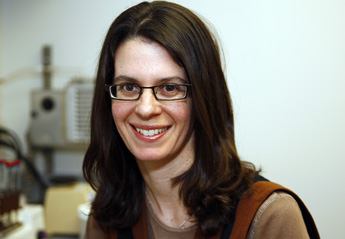
Scientific Discipline
Genetics, Microbiology
Host Institution
California Institute of Technology
Current Position
Dr. Newman is also a professor of biology and geobiology at the California Institute of Technology.
Current Research
Coevolution of Microbial Metabolism and Environmental Chemistry
Research
Biography
Geobiologist Dianne Newman has learned to think big and small at the same time. And with good reason—her research focuses on the rocks on this huge planet and the tiny microbes that constantly exploit and change them.
"We're interested in the coevolution of life and Earth," she explains. "We're trying to discover when particular types of bacteria first appeared and when the major forms of metabolism evolved, because these events had a profound effect on the Earth."
Using today's living organisms as models, Newman and her research team at the California Institute of Technology are looking backward at how ancient microbes evolved and trying to interpret the signatures they left in rocks we see today. She hopes to use her knowledge of bacterial evolution to understand how modern bacteria have adapted to thrive in the human body.
"I want people to know how much fun it is to do this work. It's never dull, even for a moment," she says.
Science was not Newman's first choice when entering college. As the daughter of an American diplomat, she has international interests. She was born in Argentina and grew up in Panama, Venezuela, California, and Washington, D.C. She majored in German studies as an undergraduate at Stanford University and even spent time at a German museum translating ancient documents before opting for a science career.
"I'd always loved engineering and science, and almost majored in materials science" as an undergraduate, she recalled. When she did commit to science, it was to study environmental engineering in graduate school. "In my first semester at MIT, in 1993, I took a class in environmental microbiology and fell in love with it." She was so infatuated, she said, that, when her doctoral adviser moved to Princeton, she followed so she could continue her research. There, "I took a class in bacterial genetics, and that changed the course of my career."
At Princeton, she pored over old documents as she'd done at the museum in Germany—this time delving into reports written by scientists in the early days of bacterial genetics. These reports were "the most inspiring papers I'd ever read. What blew me away was how, with such simple and elegant experiments, they could reach major conclusions about fundamental biological processes."
Now Newman is following in the footsteps of those pioneering microbiologists. "Much of what we're doing is directed at understanding the past," she said. Her research group is trying to determine what was happening billions of years ago when the most primitive forms of life began to assemble. What scientists do know is that bacteria were creating rudimentary metabolic systems to extract whatever energy they could from a young planet.
Newman and her colleagues are inspired by rocks—most from ancient iron-rich formations in Australia and South Africa—looking for clues that explain how photosynthetic microbes arose, evolved, and began generating the oxygen we breathe now in the Earth's atmosphere. "Rocks provide the primary record of ancient events and processes, so we initially explored microbe-mineral interactions" to gather clues to the past, Newman explained.
At the heart of her research are the energy reactions that support metabolism, whether bacteria are exposed to oxygen or not. "Every cell must solve the energy-generation problem to survive," she explained. In studies of how bacteria have addressed this fundamental need in diverse environments, her lab has discovered several novel enzymes that require metal ions to function. Sometimes the results of these reactions are minerals.
In addition to studying how bacteria use minerals to generate energy, Newman's lab also studies how these metabolic processes influence the geochemistry of the surrounding environment. For example, Newman has found bacteria that can produce iron oxides similar to those found in ore deposits through photosynthesis. These bacteria have metabolic traits that are probably similar to those of the earliest photosynthetic bacteria, which inhabited Earth before the first photosynthetic bacteria began producing oxygen more than 2 billion years ago.
While Newman is probing the past, she is also looking toward the future. As an HHMI investigator, she hopes to expand her work to a whole new area. She will use her knowledge of ancient bacteria to understand how modern bacteria live in another oxygen-deprived environment: the human body.
To begin, she wants to investigate how basic metabolic reactions help certain species of infectious bacteria thrive inside closed wounds. She says her laboratory's expertise in geobiology will help bring a fresh perspective to these kinds of medical problems. Working with bacterial metabolism "inevitably leads us into areas that are as relevant to medicine as they are to the Earth sciences," she said.
Articles & News
Research Papers
Selected Research Papers




